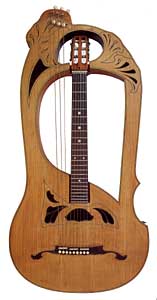|
Harp Guitar Organology
part 2
|
|
The Galleries: Harp Guitars |
||||||||||||
| Form 1b |
Form 1c |
Form 2a |
Form 2b |
Form 2c |
Form 3a |
Form 3b |
Form 3c  |
Form 4 |
Form 5  |
Composite Forms |
Other Forms |
|
|
Update: August, 2012: Since the publication of the first draft of my web thesis in April, 2004, my organization by “Form” with corresponding Photo Reference Galleries has proven not only fascinating, but useful to instrument owners, builders and researchers across the globe – from amateurs to museum professionals. And that is exactly how I intended it. However, the sheer number of historical (and now, modern) instruments took me by surprise – and since it continues to exponentially grow, I would like eventually like to clean up and better separate certain Galleries. I fully realize that instruments are poorly organized in the Galleries, with many discrepancies (some of the material is from admittedly questionable sources). But the basic system seems to be working enough for instruments to be located, studied and compared as a beginning to further research. |
|
Related Instruments Note to the casual reader
The Reference Galleries in the row below
feature historical instruments that are NOT harp guitars, |
| NOTE:
My Harp Guitar Family Tree is organized by
instrument form and characteristics. It does not represent an evolutionary or linear progression of invented forms. It is a snapshot of only those instruments involved in the discussion of harp guitars, and in no way represents a full categorization of guitars or related instruments. I’ve broken this down into what I feel are the best general, identifiable categories. There will always be experimental instruments, both historical and yet-to-be-imagined, that fall outside these convenient boxes. Likewise, there are, and will be, many examples of hybrids which combine elements from different boxes. The concepts of the entire Harp Guitar section may understandably also be applied to other fretted instruments, such as mandolins, ukuleles, steel guitars, etc (some photo examples may include other instruments for the sake of presentation). Red text indicates instruments that in basic form and function share the harp guitar’s combination of fretted strings alongside diaspon strings. Note also the two places where the name “harp guitar” occurs outside the “true” Harp Guitar family. A picture is worth a thousand words, therefore rather than list or describe examples, I include all known representative samples in the Photo Reference Library of Examples above. |

|
If you enjoyed this article, or found it useful for research, please consider supporting Harpguitars.net so that this information will be available for others like you and to future generations. Thanks!
|
|
If you enjoyed this article, or found it
useful for research, please consider making a donation to The
Harp Guitar Foundation, |
|
|
|
All Site Contents Copyright © Gregg Miner, 2004, 2005, 2006, 2007, 2008, 2009, 2010, 2011, 2012, 2013,2014. All Rights Reserved. Copyright and Fair Use of material and use of images: See Copyright and Fair Use policy. |